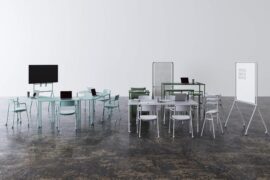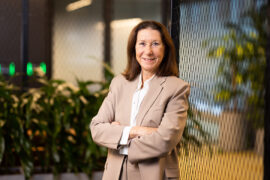In response to climate change, landscape architect and TCL Adelaide Director Damian Schultz shares important design evolutions for global play spaces.

Glenthorne National Park Ityamaiitpinna Yarta, TCL and Karl Winda Telfer and Tikana Telfer, photo by Jackie Gu.
August 22nd, 2024
Outdoor playgrounds have long been essential to society. When well-designed, these places prioritise fun, exploration and education for children and their caregivers, helping them forge stronger connections with nature and each other. Today, these playgrounds also serve as a digital detox, where screen time ends and playtime begins.
But as the earth heats up, climate change threatens to narrow the window for how many months of the year children can comfortably enjoy outdoor play. As a father of four and landscape architect, I’m passionate about countering that threat with courageous and inventive design solutions.

Outdoor playgrounds must be considerate of the climate. Heat mitigation should permanently be embedded in the design of these spaces. While heat mitigation strategies may vary according to briefs and budgets, I recommend considering insulated play equipment, shading, integrated waterplay and ‘cool-down’ zones.
I’m drawing upon recent international and national experience. Most recently, our TCL team – together with Karl Winda Telfer and Tikana Telfer – were all awarded three Australian Institute of Landscape Architects (AILA) South Australia awards and an Australian Institute of Architects’ award for our Glenthorne National Park Nature Playspace design. Meanwhile overseas, TCL led the landscape architecture design for three National Museum of Qatar (NMoQ) Playgrounds adjacent to the museum, which Atelier Jean Nouvel designed.

Creating microclimates for playgrounds
Since the seventies, sun/shade modelling has been used to help designers locate the hottest and most shaded parts of a project site. But what if improved microclimates could be created within these pre-existing conditions? I believe this is possible.
Lowering the landscape is an excellent place to start. Shaded valleys are always cooler than higher land, so, if possible, creating a localised depression works well for playgrounds. I also recommend keeping the playground’s footprint tight. Consolidating the play spaces into a smaller area will circumvent having to cover vast areas with shade or using cooling water play elements. Additionally, I suggest configuring large play structures to maximise cross-ventilation and use cooling breezes.

Uncovering new ways to cool playgrounds
Learnings from my designs for NMoQ can be leveraged across Australia, where longer, hotter summers are here to stay across our outdoor spaces.
Qatar can reach up to 50 degrees, so we knew that to reduce the temperatures of these playgrounds, we needed to think outside the box. In collaboration with a German engineer, our team undertook an extensive research and development phase. We then developed a bespoke design for outdoor misting fans suitable for playground installations.
Related: Award-winning Bradbury Park Playscape

The fans – controlled by a weather station – monitored humidity and calculated the volume and velocity of water required to cool the air. Then, water was expelled from the fans (at high pressure) to reduce air temperature by evaporation. The result? A reduction of up to ten degrees in air temperature within the plume of airflow.
In addition to soaring temps, the NMoQ project was also challenged by high winds. One of the playgrounds, the Adventure Ship, incorporated several sails in its design, providing shade across the playground. To guard against high wind speeds, we led yet another innovation. Working closely with a Sydney-based sail manufacturer, incisions were made in the sails’ PVC membrane, reinforced with another layer of welded fabric, allowing the cut sections to open and close as the wind passed through them.
Not only were the sails’ wind loads significantly reduced, but another pleasing outcome emerged. As the flaps in the sails open and closed at different times, a beautiful pattern emerges on the ground below. The result is a dappled shaded light that resembles sunlight passing through Eucalypt trees.

Rethinking popular play equipment
Slides made of stainless steel provide the best play experience. But in Qatar and Australia, outdoor stainless steel is notorious for holding extreme heat. Determined to find a solution for the NMoQ playgrounds that could work equally well in Australia, we devised a way to chill the two slides.
The design team ran chilled water through the slides by redeploying some of the water from parts of the playground explicitly dedicated to ‘water play’ (like splashing and spraying). In addition to shading the slides and providing insulation, this strategy significantly lowered the temperature of the stainless steel.
Regardless of a playground’s climate and location, I believe one universal design rule always applies: a playground must be playful. Ultimately, that creates a great space because it brings joy.
TCL
tcl.net.au





INDESIGN is on instagram
Follow @indesignlive
A searchable and comprehensive guide for specifying leading products and their suppliers
Keep up to date with the latest and greatest from our industry BFF's!

The undeniable thread connecting Herman Miller and Knoll’s design legacies across the decades now finds its profound physical embodiment at MillerKnoll’s new Design Yard Archives.
The new range features slabs with warm, earthy palettes that lend a sense of organic luxury to every space.

Welcomed to the Australian design scene in 2024, Kokuyo is set to redefine collaboration, bringing its unique blend of colour and function to individuals and corporations, designed to be used Any Way!

London-based design duo Raw Edges have joined forces with Established & Sons and Tongue & Groove to introduce Wall to Wall – a hand-stained, “living collection” that transforms parquet flooring into a canvas of colour, pattern, and possibility.

Across four decades, Leone Lorrimer LFRAIA GAICD reshaped Australian architecture through strategic vision, global influence and fearless leadership.

‘Come Together’ takes a global view of multigenerational design, an increasingly popular phenomenon with some especially notable examples in Australia.
The internet never sleeps! Here's the stuff you might have missed

Founded by Ana Ćalić McLean and Josh McLean, In Addition is a design studio creating thoughtful, client-focused architecture and interiors.

Entertaining outdoors is fundamental to Italian culture, and homes, hotels and restaurants embrace patios, terraces and gardens that celebrate scenery, climate and comfort.